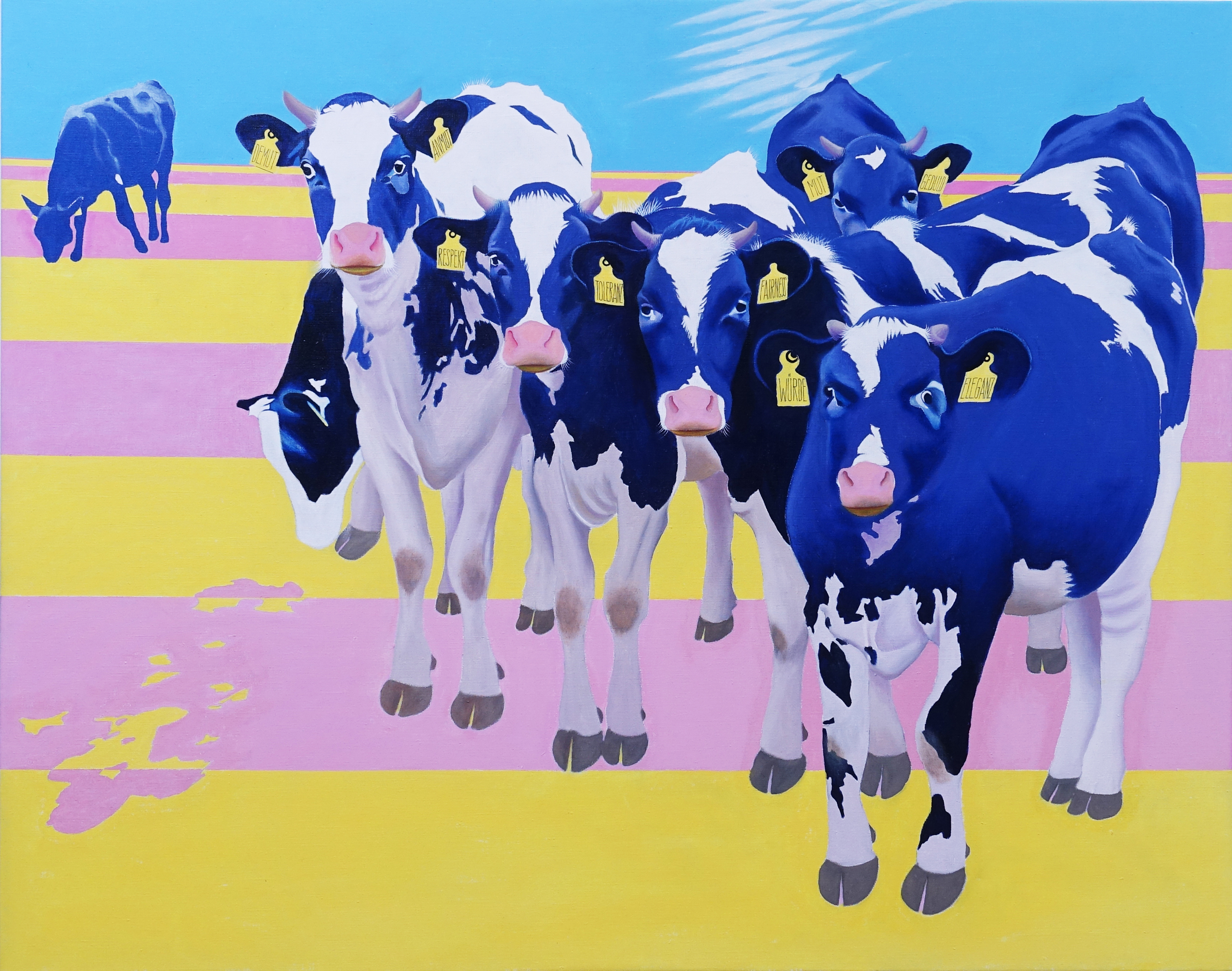
Good Morning Mrs Zurich
2025, oil and acrylic on canvas, 140x110cm

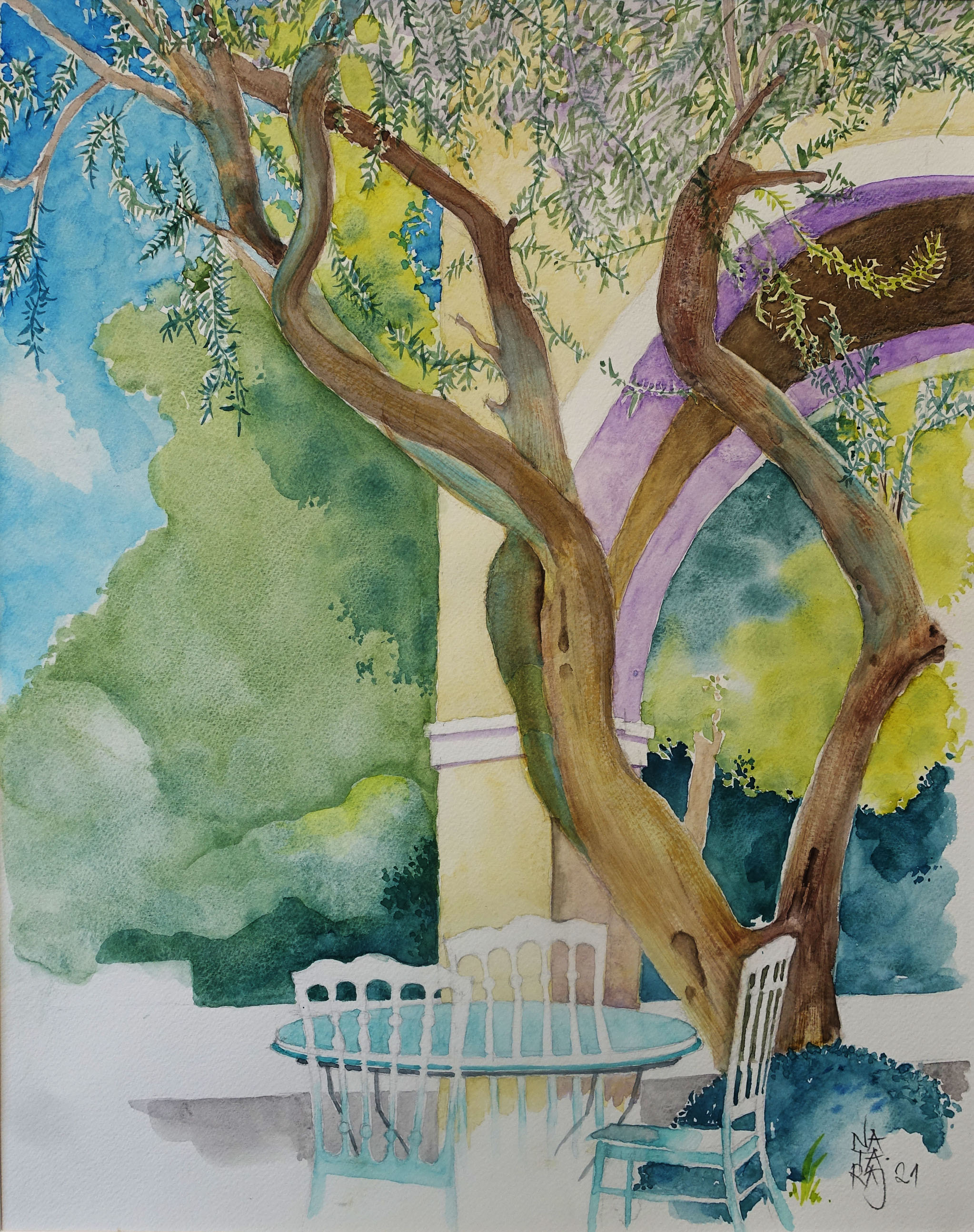

Watercolor Paintings Greece
2022

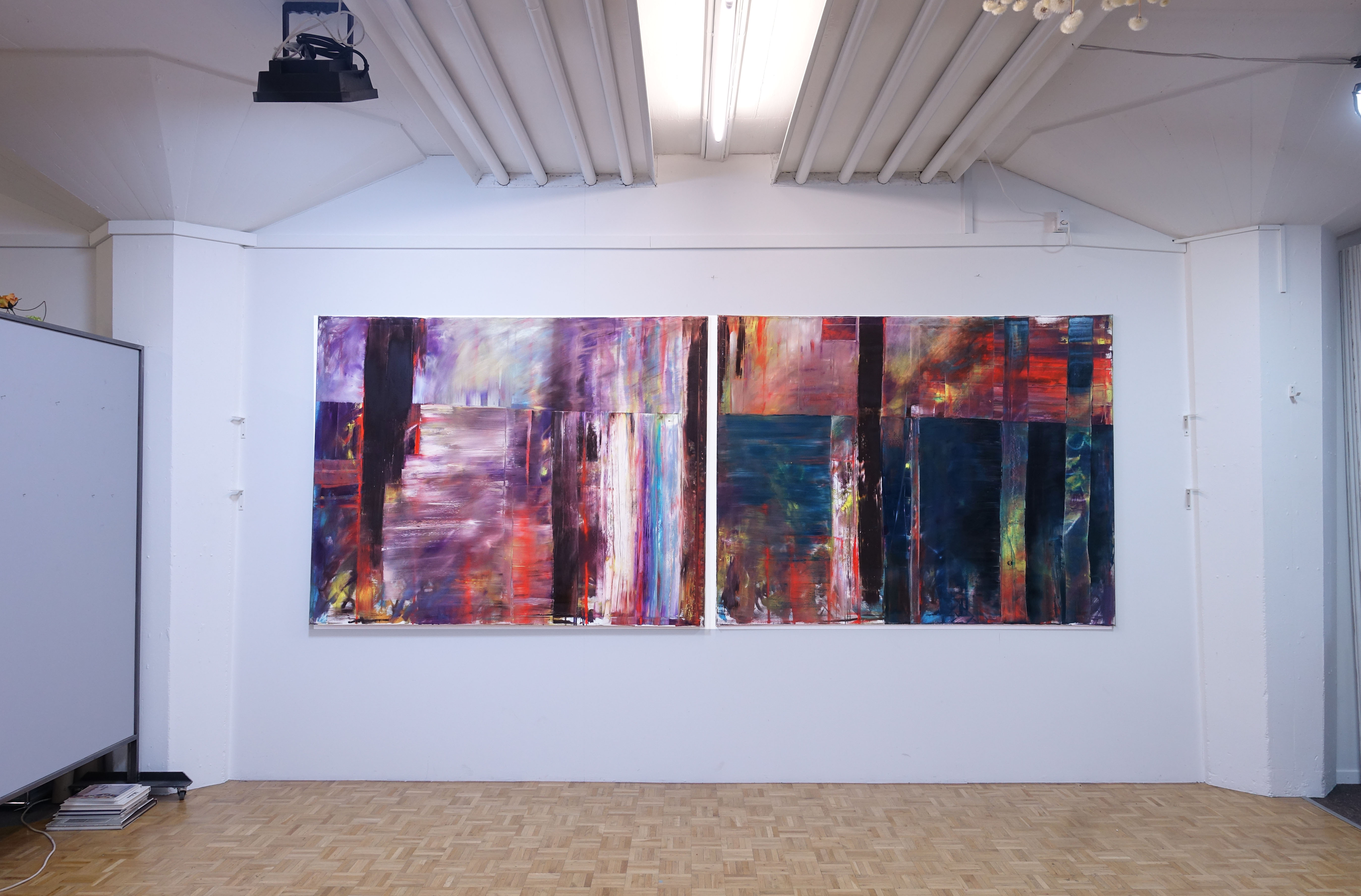
The Souls Landscape
1996


"Ghost game", size 150X190cm, oil on canvas
Questioning the picture "Ghost game"
2021
A) What are the people in the picture doing?
In the countryside near Monrovia/Liberia, a person has died of Ebola. The body is lying in this body bag. Friends, relatives and acquaintances accompany the deceased to his final resting place.
B) Why are most of those accompanying him wearing football shirts?
They symbolize the spread of Ebola (Liberia) in Africa and Covid-19 in the rest of the world (Wuhan FC, Atalanta Bergamo, Real Madrid, Paris Saint Germain, Arsenal London, New York City and national jerseys Brazil and Liberia) by football clubs.
C) Why is the scene taking place in a football stadium?
During the pandemic, all sporting events, including football, were forbidden, so the pitch is a red restricted area. However, the poeple who look like players at first glance are not and leave the pitch. They are simple people from the village who have dreams: A lot of young African wants to play in a European football team. The picture is therefore also a projection of dreams.
D) Why do the three corpse bearers representing the continents of Africa (Liberia), Asia (Wuhan) and Europe (Bergamo) wear red beaks?
They quote the Venetian plague doctors from 14th to 17th century. The length of the noses protects the doctors from the plague pathogens. They make a historical reference to the topic of epidemics.
E) What does the small picture in the background mean?
It is the Lamentation of Christ, a fresco by Giotto from 1300 from the Arena Chapel in Padua. Like the Mother of God, Mary Magdalene and the disciples mourn for Jesus, the people of Monrovia mourn for their friend, which is why the scene can be be interpreted as a modern lamentation of Christ.
F) Why is there a "flying fox" hanging in the stadium?
The Ebola virus and the Covid-19 virus were both found on the flying fox. However, it is immune to these viruses. The flying fox turns the world upside down.
G) What is behind the color and structural relationship between the "flying fox" and the body bag?
Beginning and end of an infection?
H) What does the light blue disk at the top of the picture mean?
Is it a soccer ball without a game?
Is it the moon in the night sky?
Is it a "masked ball" symbolizing the global pandemic?
I) What does the sentence on the band mean?
This is a haiku, a Japanese three-line poem with the following statement:
The nightingale sings
this hopeful song
in the hour of farewell...
The nightingale stands for the lovers (Romeo & Juliet), protects the sick and accompanies the dead safely into the realm of the dead.
J) Why is the corner flag here a plant?
The "annual weed" (Erigeron annuus) is an invasive neophyte that is spreading uncontrollably in Europe, like Covid-19 around the globe.
K) Who is the elderly gentleman with his hand raised and the Chinese labeled cap?
He is a memorial to the Chinese journalist who was the the first journalist to visit hospitals in Wuhan and wrote about the new Corona virus and has since disappeared.
L) How many people have died from Covid-19 and Ebola?
From Covid-10: 6.8 million
From Ebola in Liberia and West Africa: 13,500
«Geisterspiel» 190x150cm, oil on canvas, from 16 November – 8 December 2024 at the International Exhibition for Contemporary Art: ART LAGUNA PRIZE, Arsenal Nord, Venice
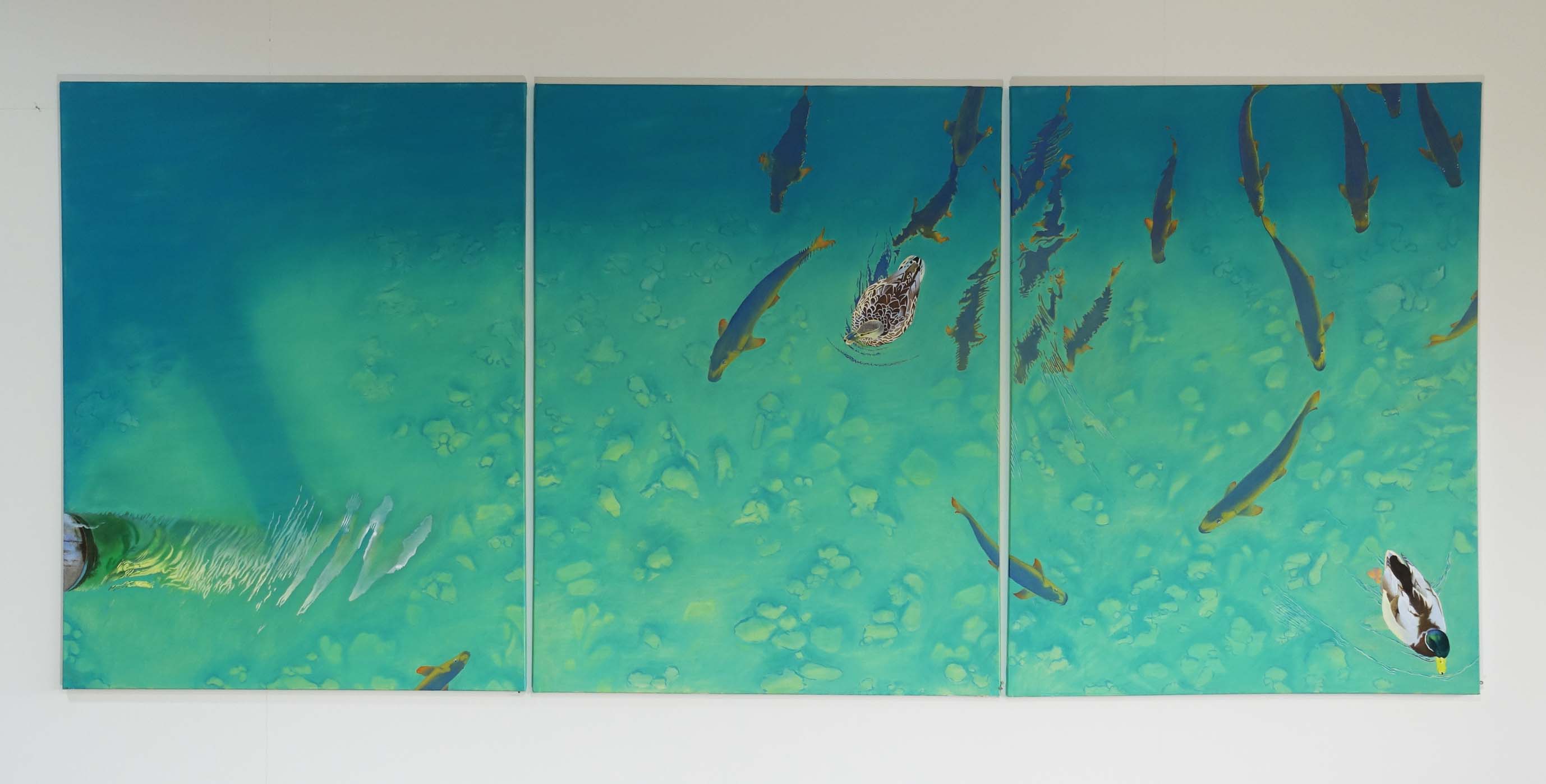
Götti-Bach-Stäg, Tryptichon, oil on canvas, 288X125cm
2020
The swarms of barbels that romp around under the "Götti-Bach-Stäg"/Bridge in Thun in the Aare were photographed with my mobile phone on a beautiful November morning in 2019 from the Stäg / Bridge. Based on those photos, compositional variants were created, one of which was then implemented in oil. The first time I tried to work with large-scale oil glazes. Every third of the
triptych also stands for itself. However, all three parts result in a superordinate whole, e.g. emptiness and abundance, individual and group, movement and silence etc. An important motivation for this picture theme were the ducks, which set the water surface in motion, so that some fish are optically deformed. but others appear as an intact shade.
Oil studies from Greece and corresponding preliminary drawings in pencil ( Preliminar Sketches)
2018
Portrait sketches from various sketchbooks
2003-2021
What if someone who is signed off notices? I was asked again and again. It happened to me twice in 20 years. Once the involuntary model did not show anything while drawing. When we both got off the train, the lady in white came straight to me, wanted to see the sketch and asked for it immediately, without saying a word about the quality of the portrait or its similarity to the model. I folded the sheet of paper, scratched it several times with my
fingernail, and tore the page out and gave it to her. The lady took the sheet of paper and disappeared into the crowd of travelers on the platform. Fortunately, the sketch hadn't turned out very well. So no reason not to do it for the next 20 years.
But what to do if someone moves while drawing?
Over the years I have found out that people keep going back to a resting position that emerges after 2-3 minutes of observation. This is suitable for making the first lines and determining the posture of the model. Soon the model looks out of the window on the train, for example, or at the
opposite side of the compartment, but then with a high probability it will take up this starting position again, here you just need a little patience and trust in the repeatability of the things in life. A journey is often accompanied by a sketchbook. For years also on the way to work from Thun to Burgdorf and back, mostly by regional train through the
peaceful, gentle Emmental. This route is wonderfully suited to immortalizing fellow travelers in a sketchbook. I often had an easy job because my sleeping model didn't move. Another advantage is when people talk to each other, then the model is distracted from the observer who is drawing. When people notice that they are being drawn, they suddenly get embarrassed and often become unnatural, posture and gestures become artificial, then it is better to stop drawing. Sometimes I was so gripped that I was still working on it at home, adding a background or correcting a hand. The best experience for me was drawing on the boat trip from Venice to Patras. Water calms down and the passengers have plenty of time to sit on deck, in the café, at the bar or in the dining room. They endured being portrayed very patiently. Is there a more inspiring environment than the white ship architecture with the deep blue horizon in the background?
The sketches are not in chronological order and were created between 2003 and 2011. Most of the sketches, on the other hand, are the result of drawing in train station buffets and cafés, or at family celebrations or excursions. A special experience was accompanying a dying friend and drawing on the deathbed. One last hour with him while the two funeral home employees, dressed in black with a black tie, waited patiently outside.
Nude drawings from sketchbook
1996-2016
Watercolor - Paintings, Genoa
1996 / 1997
Rusty colossi after having traveled thousands of nautical miles land in the dry dock, e.g. in the port of Genoa, where the barges are derusted and repainted. I tried to capture the building site atmosphere in this industrial landscape, the workers on the scaffolding, the cranes, the mountains of ropes with the 5-man-sized anchors, the bollards, the endless rusty surfaces on large-format watercolor paper with quick brushstrokes, practically without preliminary drawings.
Surreally, these water vehicles appear jacked up in the dry in the so-called Bacini, huge tubs from which the water has been pumped away from under the ship. The aim was to relate the tiny size of the viewer, the painter to the stranded colossi with their rusty signs of history, and to confront them with the lightness of the watercolor stains.
Diptichon: All in one, one in all, oil on canvas
1996
| After the birth of my son, I gave a lot of thought to the individual and society, about self-realization and adaptation, |
| about going against the current or going with the current. This diptichon was created from these considerations. |
Diptichon: Alone in Space
1996
| AKT bamboo pen drawing with brown ink, washed in places |
1995
Panel paintings: abstract watercolors on white-coated chipboards, 28x24cm
1999
The white coating material that is used for kitchen furniture cladding and cupboards, etc., i.e. for surfaces that can be cleaned practically in everyday life, is exactly the opposite of a common painting base for a watercolor, which absorbs the color accordingly and paints the well-known effects, or have it generated by chance.
The coating material is afraid of water, the stains of color contract, creating random structures that are spread flaky on the surface. This effect can be partially neutralized by using ox gall. Abstraction is the most obvious product of this process.
All «Untitled», without brackets: consecutive numbering of the images
Gigi, 113x92, oil on canvas
1995
Room installation: Stories in Red and White
1999
Die Erlauchten, 92x112, oil on canvas
1995
Informel, oil on canvas
Where fire, earth,
water and air meet
Fresh wildness
Autumn poetry
Colorful Jungle
(jungle camp)
1995

Ocher marin in a duel, oil on canvas
1995
Golden conscience: Switzerland and its Nazi gold 1997 - A project in the landscape
1997
|
- To give room for discomfort, a place, a forum where we can learn to “accept it”, as Federal Councilor A. Koller said in his speech in early March 1997.
|


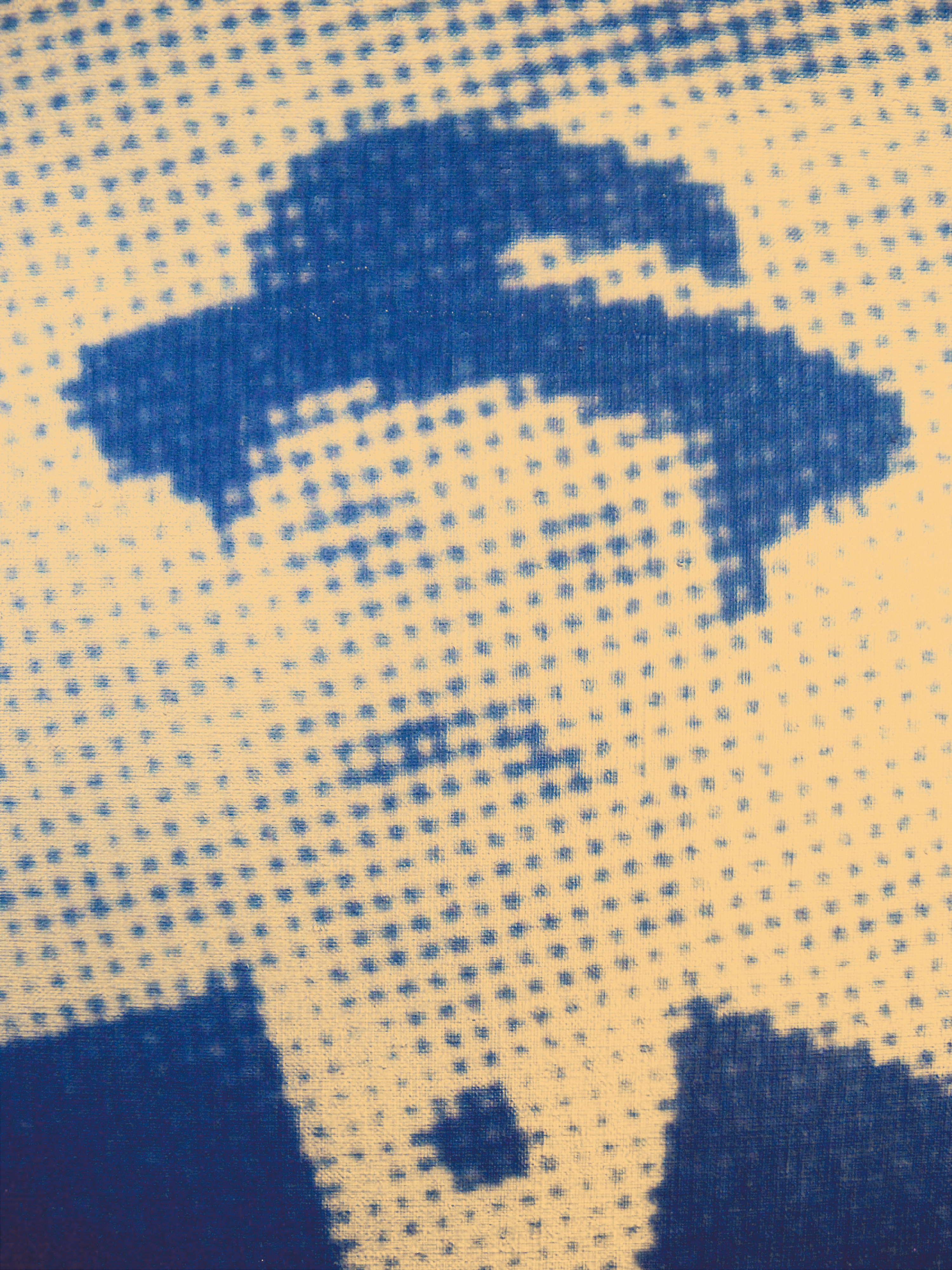
Singing dead gold: inkjet print Michelangelo on canvas, 450 x150 cm
1997

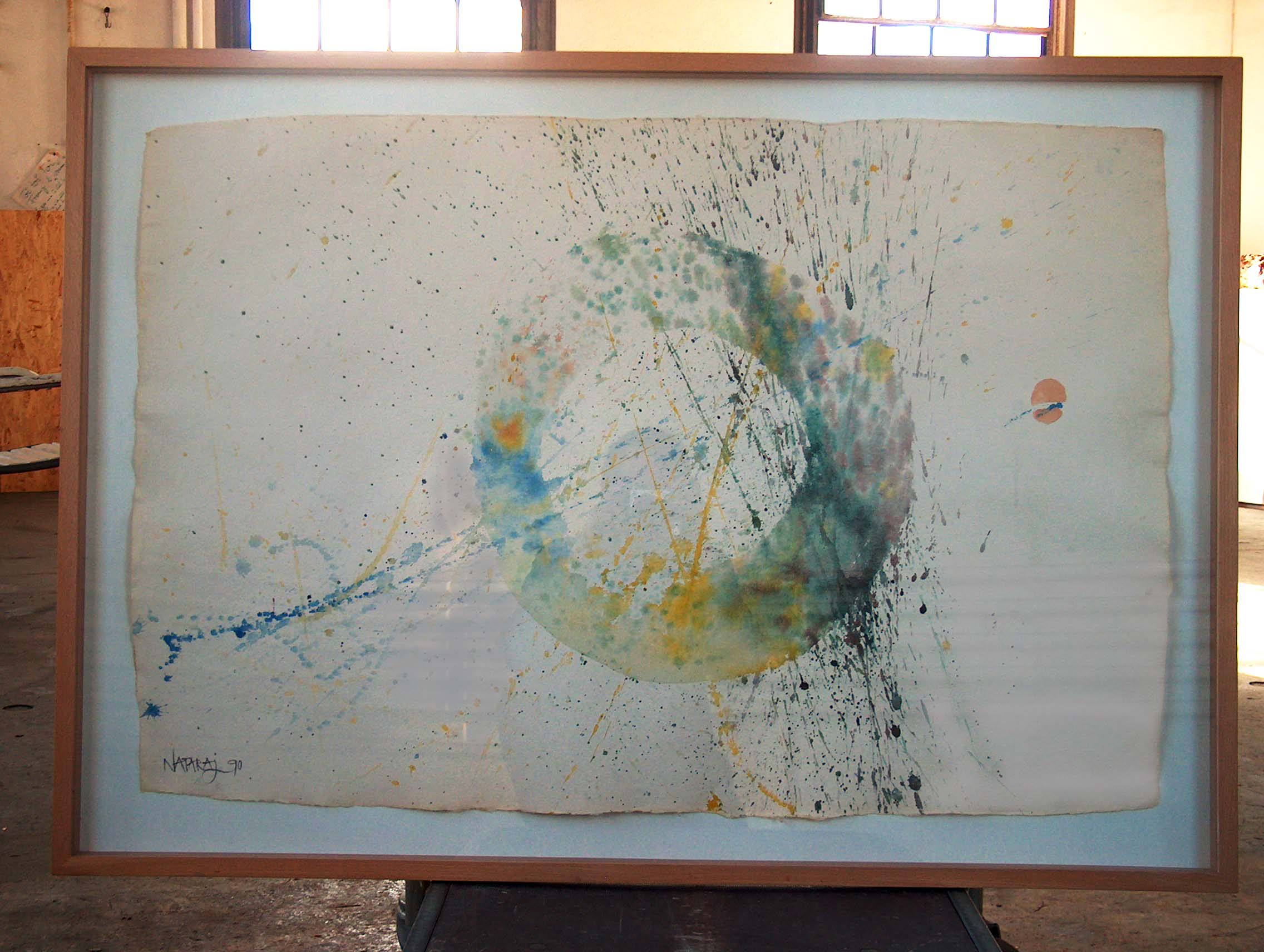
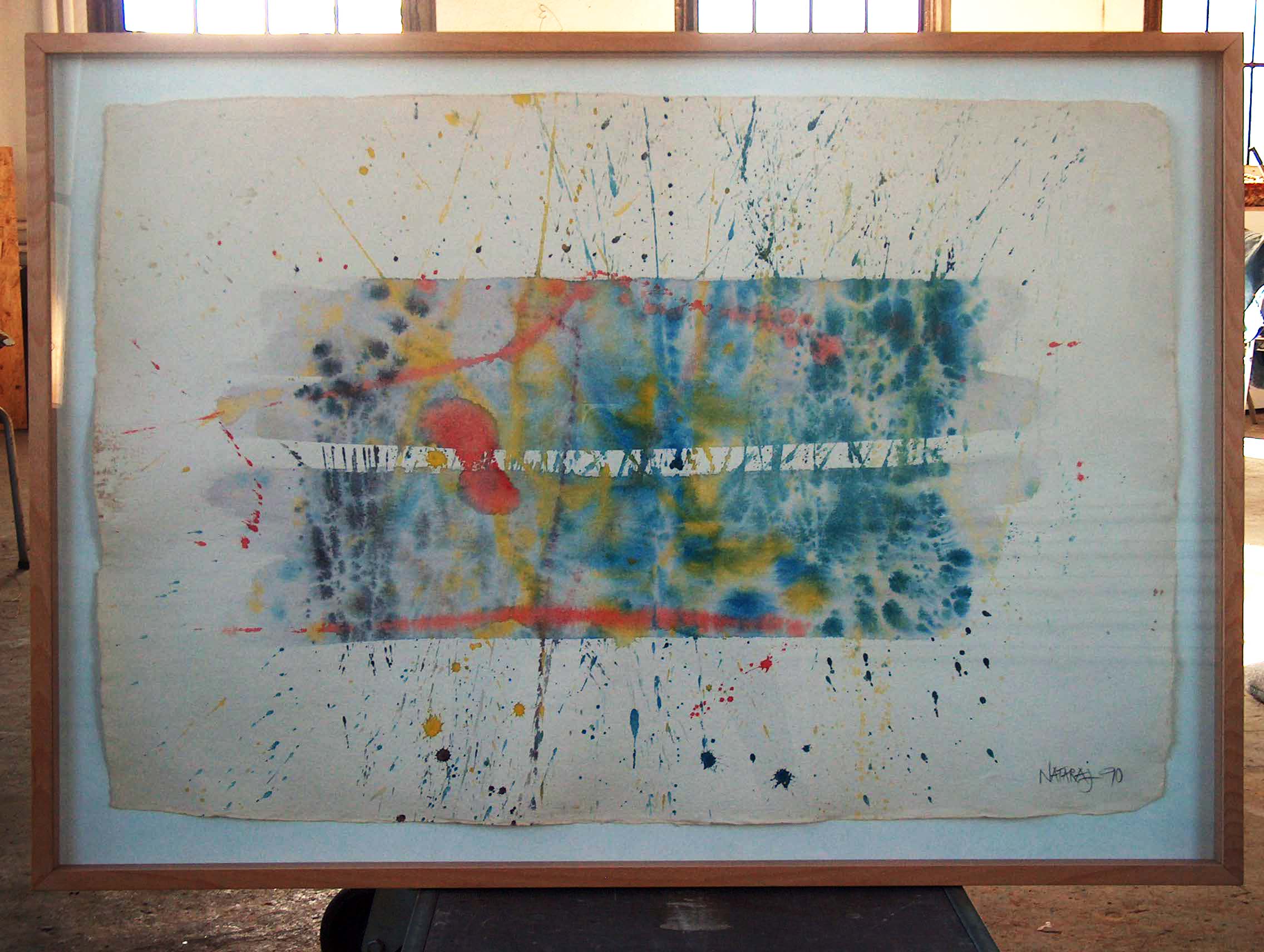


Abstract watercolors were created in an ashram in India |
1990
These waterclors were created in India near Pune, a city about 5 hours’ drive southeast of Mumbay. Before painting, I visited a paper factory and was able to watch in an opan factory hall how the papers were scooped into large basins.
The paper is characterized by a rough surface. The roughness then required large brushes and a generous way of working.
So-called Sock pictures
1993
Interieur Aquarell, Duftende Orangen, 29x39
1996
Landscape watercolours
1994-1996
Wohlensee, Schadau, Ernen, Thunersee, Wien, Bern, Emmenthal, Lipari, Korsika, Filicudi.
Stage designs for “ The Giants from the Mountains” by Luigi Pirandello, (Stadttheater Bern 1987)
1987
Room installations 1987: face and mask
1987
Old Tobler factory building,
Draft profile for space mask,
Mask installation
“Rebgases” and fish paste: material for room installation
Wall installation: Honorary professors with frown lines on old factory walls
1987

Good Morning Mrs Zurich
2025, oil and acrylic on canvas, 140x110cm



Watercolor Paintings Greece
2022


The Souls Landscape
1996


"Ghost game", size 150X190cm, oil on canvas
2021
A) What are the people in the picture doing?
In the countryside near Monrovia/Liberia, a person has died of
Ebola. The body is lying in this body bag. Friends, relatives and acquaintances accompany the deceased to his final resting place.
B) Why are most of those accompanying him wearing football shirts?
They symbolize the spread of Ebola (Liberia) in Africa and Covid-19 in the rest of the world (Wuhan FC, Atalanta Bergamo, Real Madrid, Paris Saint Germain, Arsenal London, New York City and national jerseys Brazil and Liberia) by football clubs.
C) Why is the scene taking place in a football stadium?
During the pandemic, all sporting events, including football, were forbidden, so the pitch is a red restricted area. However, the poeple who look like players at first glance are not and leave the pitch. They are simple people from the village who have dreams: A lot of young African wants to play in a European football team. The picture is therefore also a projection of
dreams.
D) Why do the three corpse bearers representing the continents of Africa (Liberia), Asia (Wuhan) and Europe (Bergamo) wear red beaks?
They quote the Venetian plague doctors from 14th to 17th century. The length of the noses protects the doctors from the plague pathogens. They make a historical reference to the topic of epidemics.
E) What does the small picture in the background mean?
It is the Lamentation of Christ, a fresco by Giotto from 1300 from the Arena Chapel in Padua. Like the Mother of God, Mary Magdalene and the disciples mourn for Jesus, the people of Monrovia mourn for their friend, which is why the scene can be be interpreted as a modern lamentation of Christ.
F) Why is there a "flying fox" hanging in the stadium?
The Ebola virus and the Covid-19 virus were both found on the flying fox. However, it is immune to these viruses.
The flying fox turns the world upside down.
G) What is behind the color and structural relationship between the "flying fox" and the body bag?
Beginning and end of an infection?
H) What does the light blue disk at the top of the picture mean?
Is it a soccer ball without a game?
Is it the moon in the night sky?
Is it a "masked ball" symbolizing the global pandemic?
I) What does the sentence on the band mean?
This is a haiku, a Japanese three-line poem with the following statement:
The nightingale sings
this hopeful song
in the hour of farewell...
The nightingale stands for the lovers (Romeo & Juliet), protects the sick and accompanies the dead safely into the realm of the dead.
J) Why is the corner flag here a plant?
The "annual weed" (Erigeron annuus) is an invasive neophyte that is spreading uncontrollably in Europe, like Covid-19 around the globe.
K) Who is the elderly gentleman with his hand raised and the Chinese labeled cap?
He is a memorial to the Chinese journalist who was the the first journalist to visit hospitals in Wuhan and wrote about the new Corona virus and has since disappeared.
L) How many people have died from Covid-19 and Ebola?
From Covid-10: 6.8 million
From Ebola in Liberia and West Africa: 13,500
«Geisterspiel» 190x150cm, oil on canvas, from 16 November – 8 December 2024 at the International Exhibition for Contemporary Art: ART LAGUNA PRIZE, Arsenal Nord, Venice

Götti-Bach-Stäg, Tryptichon, oil on canvas, 288X125cm
2020
The swarms of barbels that romp around under the "Götti-Bach-Stäg"/Bridge in Thun in the Aare were photographed with my mobile phone on a beautiful November morning in 2019 from the Stäg / Bridge. Based on those photos, compositional variants were created, one of which was then implemented in oil. The first time I tried to work with large-scale oil glazes. Every third of the
triptych also stands for itself. However, all three parts result in a superordinate whole, e.g. emptiness and abundance, individual and group, movement and silence etc. An important motivation for this picture theme were the ducks, which set the water surface in motion, so that some fish are optically deformed. but others appear as an intact shade.
Oil studies from Greece and corresponding preliminary drawings in pencil ( Preliminar Sketches)
2018
Portrait sketches from various sketchbooks
2003-2021
What if someone who is signed off notices? I was asked again and again. It happened to me twice in 20 years. Once the involuntary model did not show anything while drawing. When we both got off the train, the lady in white came straight to me, wanted to see the sketch and asked for it immediately, without saying a word about the quality of the portrait or its similarity to the model. I folded the sheet of paper, scratched it several times with my
fingernail, and tore the page out and gave it to her. The lady took the sheet of paper and disappeared into the crowd of travelers on the platform. Fortunately, the sketch hadn't turned out very well. So no reason not to do it for the next 20 years.
But what to do if someone moves while drawing?
Over the years I have found out that people keep going back to a resting position that emerges after 2-3 minutes of observation. This is suitable for making the first lines and determining the posture of the model. Soon the model looks out of the window on the train, for example, or at the
opposite side of the compartment, but then with a high probability it will take up this starting position again, here you just need a little patience and trust in the repeatability of the things in life. A journey is often accompanied by a sketchbook. For years also on the way to work from Thun to Burgdorf and back, mostly by regional train through the
peaceful, gentle Emmental. This route is wonderfully suited to immortalizing fellow travelers in a sketchbook. I often had an easy job because my sleeping model didn't move. Another advantage is when people talk to each other, then the model is distracted from the observer who is drawing. When people notice that they are being drawn, they suddenly get embarrassed and often become unnatural, posture and gestures become artificial, then it is better to stop drawing. Sometimes I was so gripped that I was still working on it at home, adding a background or correcting a hand. The best experience for me was drawing on the boat trip from Venice to Patras. Water calms down and the passengers have plenty of time to sit on deck, in the café, at the bar or in the dining room. They endured being portrayed very patiently. Is there a more inspiring environment than the white ship architecture with the deep blue horizon in the background?
The sketches are not in chronological order and were created between 2003 and 2011. Most of the sketches, on the other hand, are the result of drawing in train station buffets and cafés, or at family celebrations or excursions. A special experience was accompanying a dying friend and drawing on the deathbed. One last hour with him while the two funeral home employees, dressed in black with a black tie, waited patiently outside.
Nude drawings from sketchbook
1996-2016
Watercolor - Paintings, Genoa
1996 / 1997
Rusty colossi after having traveled thousands of nautical miles land in the dry dock, e.g. in the port of Genoa, where the barges are derusted and repainted. I tried to capture the building site atmosphere in this industrial landscape, the workers on the scaffolding, the cranes, the mountains of ropes with the 5-man-sized anchors, the bollards, the endless rusty surfaces on large-format watercolor paper with quick brushstrokes, practically without preliminary drawings.
Surreally, these water vehicles appear jacked up in the dry in the so-called Bacini, huge tubs from which the water has been pumped away from under the ship. The aim was to relate the tiny size of the viewer, the painter to the stranded colossi with their rusty signs of history, and to confront them with the lightness of the watercolor stains.
Diptichon: All in one, one in all, oil on canvas
1996
| After the birth of my son, I gave a lot of thought to the individual and society, about self-realization and adaptation, |
| about going against the current or going with the current. This diptichon was created from these considerations. |
Diptichon: Alone in Space
1996
| AKT bamboo pen drawing with brown ink, washed in places |
1995
Panel paintings: abstract watercolors on white-coated chipboards, 28x24cm
1999
The white coating material that is used for kitchen furniture cladding and cupboards, etc., i.e. for surfaces that can be cleaned practically in everyday life, is exactly the opposite of a common painting base for a watercolor, which absorbs the color accordingly and paints the well-known effects, or have it generated by chance.
The coating material is afraid of water, the stains of color contract, creating random structures that are spread flaky on the surface. This effect can be partially neutralized by using ox gall. Abstraction is the most obvious product of this process.
All «Untitled», without brackets: consecutive numbering of the images
Gigi, 113x92, oil on canvas
1995
Room installation: Stories in Red and White
1999
Die Erlauchten, 92x112, oil on canvas
1995
Informel, oil on canvas
Where fire, earth,
water and air meet
Fresh wildness
Autumn poetry
Colorful Jungle
(jungle camp)
1995

Ocher marin in a duel, oil on canvas
1995
Golden conscience: Switzerland and its Nazi gold 1997 - A project in the landscape
1997
|
- To give room for discomfort, a place, a forum where we can learn to “accept it”, as Federal Councilor A. Koller said in his speech in early March 1997.
|



Singing dead gold: inkjet print Michelangelo on canvas, 450 x150 cm
1997





Abstract watercolors were created in an ashram in India |